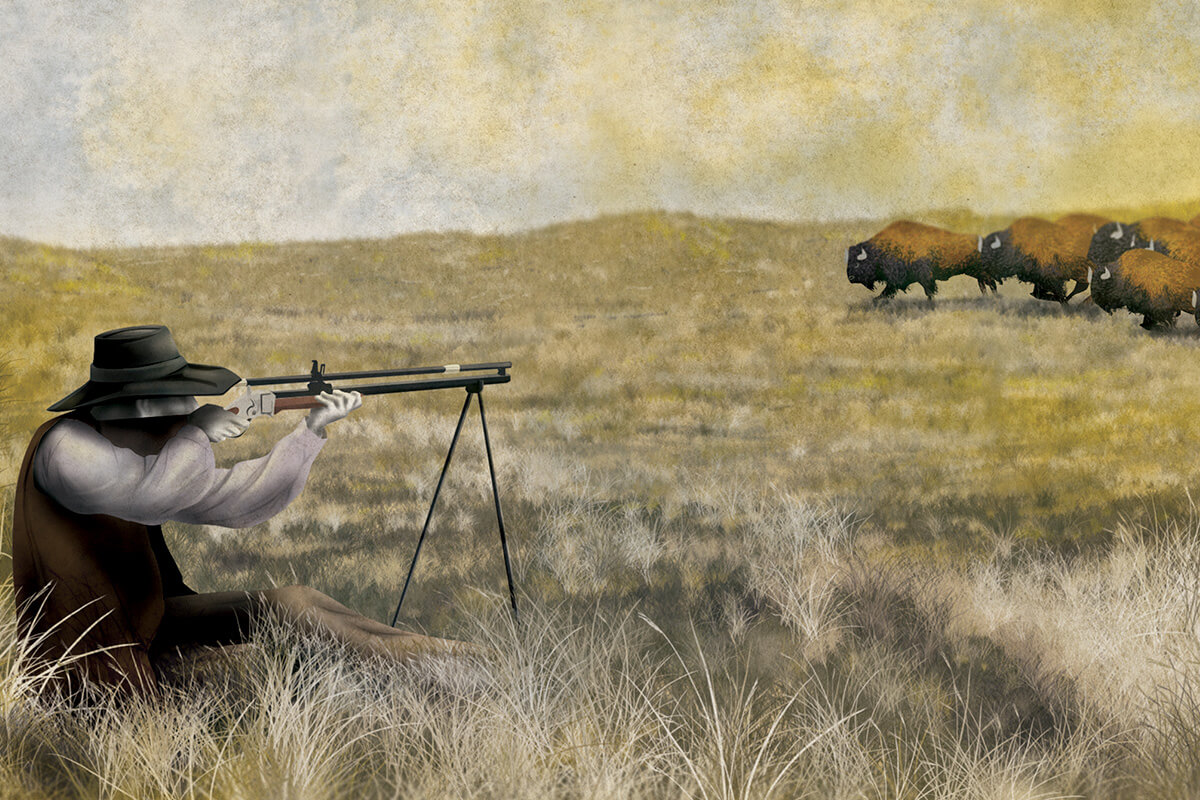
Centenarian Frank Mayer (1850–1954) was a drummer boy during the American Civil War, fought in the later Indian Wars, and served as a U.S. Marshal in Colorado. Along the way, he hunted bison professionally and turned that endeavor into a profitable, strategy-based business.
May 13, 2022
By Joel J. Hutchcroft
Born in Louisiana on May 28, 1850, Frank H. Mayer lived to the ripe old age of 103 years and nine months. During his long, adventurous life, he became an expert marksman, and one researcher called him a “true, dyed-in-the-wool gun crank.” Another writer, in the pages of our sister publication Guns & Ammo (Fall 1958 Vol. 1, Issue 2; also available at gunsandammo.com), referred to him as the “scientific buffalo hunter.”
The Mayer family moved to Pennsylvania when he was five years old. He grew up hunting and fishing and became an amateur gunsmith, learning to build muzzleloaders. He also learned to be a fine rifle shot, often beating older shooters in informal competitions. His first favorite rifle was a full-stock Kentucky rifle with a 51-inch barrel and double-set triggers. Later, he would begin his bison-hunting business with Sharps breechloading rifles, but he never abandoned that old Kentucky rifle. One report stated he had used it so much during his lifetime that he shot out the bore and had the rifling recut three times.
At age 13, he joined the Union Army as a drummer boy and reportedly witnessed some of the greatest battles of the Civil War, including Gettysburg. After the war, he earned a degree at the Columbia School of Mines in New York. And by 1872, he had ventured to Mexico, where he managed a smelter. He spent the stake he made there on good equipment for his hide-hunting venture.
With his keen mind and logical approach to becoming a professional hunter, he preferred Sharps breechloading rifles. His favorite was a .45-120-550, to which he had attached a German10X scope, and he honed his shooting skills to the point where he generally needed only a single shot to bring down a bison. Also, he was an accomplished handloader and is credited with devising a steel bipod that attached to the barrel of his rifle.
From 1872 to 1878 (or possibly 1881, accounts vary), Mayer and his company made hide hunting a profitable business by applying a well-thought-out strategy. He preferred to make neck shots at ranges of about 200 yards or less. He generally did not like to shoot from too close (where shots would spook the buffalo) or from too far away (risking just wounding the animal). And he did not care to shoot as many bison as possible. Rather, his practice was to take, on average, 30 buffaloes per day, which was the number his three skinners could accommodate with the least amount of waste. Mayer’s shooting prowess was legendary.
Bison weren’t the only things Mayer encountered on the Great Plains. In later writings, he claimed to have made an incredibly “lucky” 400-yard shot on a Comanche war chief that abruptly ended their attack.
After years of hide hunting, he tired of the wonton slaughter and reenlisted in the U.S. Army, eventually serving for 35 years and being promoted to the rank of Lieutenant Colonel. He participated in various Indian Wars and the Spanish-American War of 1898. Afflicted with wanderlust, at the age of 63, he ventured to the diamond mines of Australia and then to Brazil where he helped build a railroad and then to Colorado where he became a U.S. Marshal. He continued to hunt throughout his life, including moose and brown bear in Alaska, and he killed his last buck at the age of 100—or 102, again accounts vary. He passed away on February 12, 1954, three months shy of his 104th birthday.
Frank Mayer wrote three books about his adventures: The Buffalo Harvest, The Song of the Wolf, and The Unmuzzled Ox. He also wrote several articles for the National Rifle Association. Some of his exploits were no doubt exaggerated, but tall tales aside, all who have written about him agree that he had developed exceptional long-range shooting skills.